Financial Stability Review – October 2018 1. The Global Financial Environment
Australia has long been sensitive to global economic and financial trends. This sensitivity arises from trade, investment and capital flows, as well as the broader integration of the Australian financial system with global markets. Consequently, the Review pays particular attention to risks emanating from the largest economies and regions, which also dominate global financial markets, as well as those that have significant trade or financial links with Australia. These include the United States, Europe, China, Japan and New Zealand.
Recent growth in the global economy has been both solid and widespread, which is supporting global financial stability. But increasing trade protectionism poses a threat to the outlook. Asset prices in a range of markets are high and compensation for risk is low. An adverse shock could result in a broad fall in asset prices, exposing vulnerabilities that have built up in the low interest rate, low volatility environment.
High global debt levels leave households, corporates and sovereigns in a range of countries vulnerable to adverse shocks. In a number of countries, household debt levels are at historical highs relative to income, although an orderly slowdown in housing markets is underway in some cases. Debt in China is particularly high, with a large share financed through opaque non-bank lending channels. Chinese authorities' efforts to address the associated financial stability risks are showing noticeable results, but risks remain elevated. Sovereign debt levels remain especially high in Europe, and debt sustainability concerns could quickly re-escalate. This could undermine financial and economic stability, including by exacerbating banking sector vulnerabilities.
Ongoing external borrowing, macroeconomic imbalances and policy uncertainty have raised concerns about sovereign and corporate credit risks in some emerging market economies (EMEs). However, contagion has been limited so far, with the shift in market sentiment mostly affecting those countries with the greatest vulnerabilities.
The global growth outlook remains positive, but downside risks have increased
Growth in the advanced economies has been solid over the past year, which has supported global financial stability. Growth is expected to be above trend over the coming year (Graph 1.1). However, downside risks to growth have become more prominent since the previous Review, particularly due to the rise in trade protectionism. Several large economies have implemented or proposed tariff increases over the past six months. Trade tensions between the United States and China in particular have escalated. The direct impact on global growth of the measures implemented or proposed to date is likely to be relatively modest. But if the imposition of trade barriers were to intensify, or if it materially affected business sentiment and decisions, the negative impacts on economic growth could be more significant. In turn, weaker global growth would tend to increase global financial stability risks by reducing the capacity of highly leveraged borrowers to service their debt. A reassessment of the global growth outlook and risk more generally could also trigger a broad fall in asset prices.
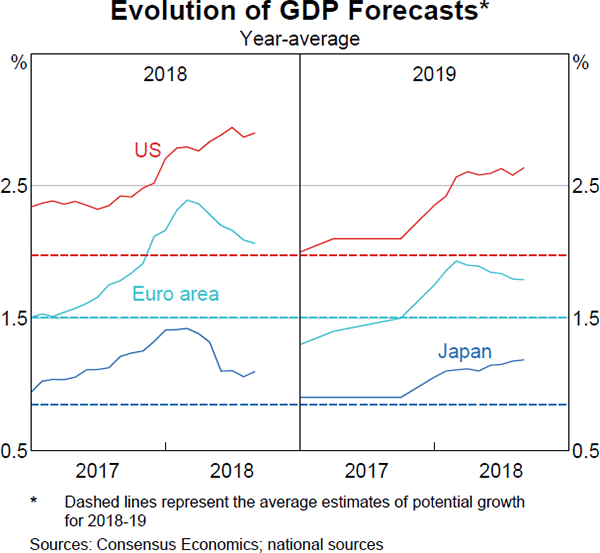
Financial asset prices are high and compensation for risk is low
Asset valuations in a range of advanced economy financial markets have risen to high levels over recent years. Strong global growth, low inflation and very accommodative monetary policy have all contributed. Government bond yields in many major advanced economies rose over the past year or so, as the United States and some other economies reduced their monetary stimulus. But policy still remains accommodative and yields are still close to historically low levels (Graph 1.2). These low risk-free rates, which are central to the valuation of many assets, are supporting high asset prices.
The compensation that investors require for bearing risk is also low. Longer-term interest rates include a term premium to compensate investors for the uncertainty of holding assets into the future. The current small term premiums suggest that investors have a high level of confidence in the projected paths of interest rates, inflation and economic growth and/or a willingness to accept only very small compensation for the risk of unexpected changes to those paths. Corporate bond spreads also remain compressed, notwithstanding an increase in some markets over the past year (Graph 1.3).
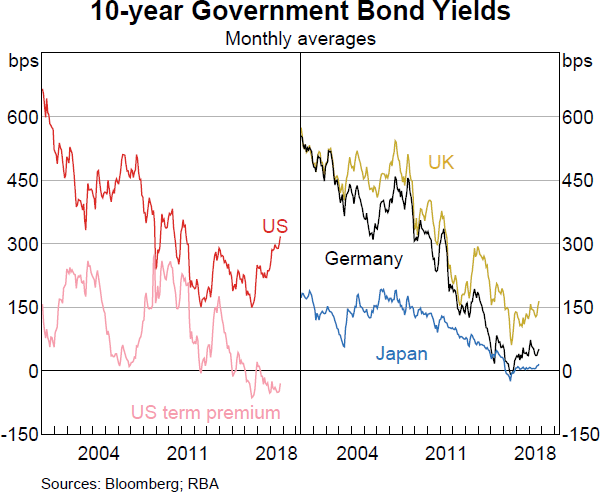
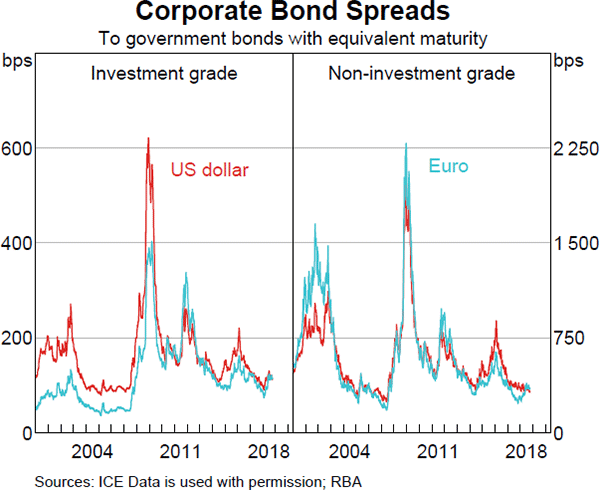
Similarly, the US equity risk premium – the compensation for investing in equities rather than risk-free government bonds – has continued to move lower (Graph 1.4). In contrast, the equity risk premium in the euro area has remained above its longer-run average. Despite the build-up of trade tensions and other global risks, equity market volatility has also returned to relatively low levels, and bond market volatility remains around all-time lows (Graph 1.5).
Along with requiring less compensation for taking on risk, investors have generally increased the amount of risk they are bearing. In particular, in order to increase returns, some have moved into lower-rated, illiquid or longer duration assets, have moved beyond their historical risk mandate or have increased their level of leverage.[1] With the price of risk so low, there is a heightened possibility that an increase in expected or realised inflation or a negative growth shock could result in a significant and widespread rise in volatility and repricing in financial assets. Some investors may not be well prepared for such repricing, with the potential for some large losses and reactive sales of assets (including due to margin calls, reduced access to funding or investment mandate restrictions).
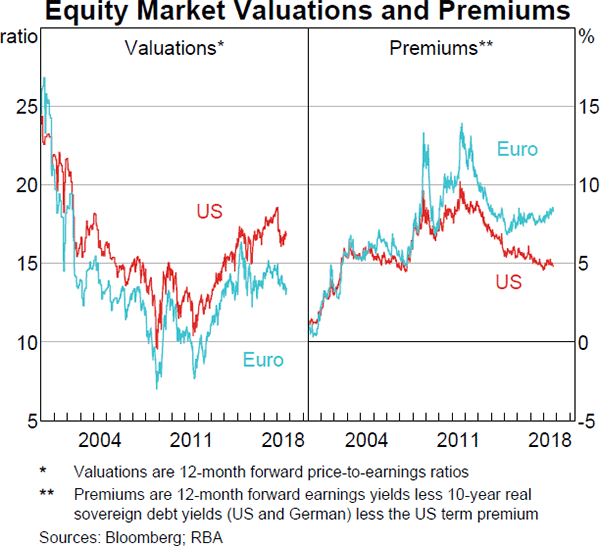
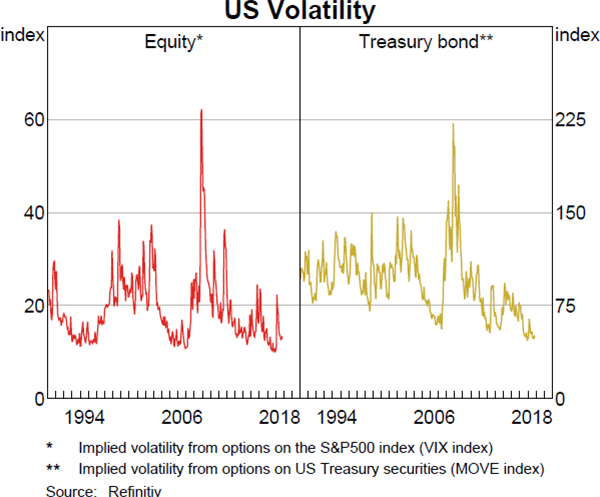
Volatility and asset price falls could be amplified by procyclical investment behaviour and the lower liquidity evident in bond markets. Investment vehicles that rely on algorithms to trade automatically, that pay off if volatility stays low, or that target a fixed level of volatility, have become increasingly popular. There is some evidence that such investment vehicles sell assets when prices are falling, thereby exacerbating price falls and volatility.[2] Open-ended bond investment funds, which have increased in size and number over recent years, may also exacerbate volatility and price falls.[3] These funds may be vulnerable due to a mismatch between easy redemption terms and the illiquid nature of some underlying bonds. Negative returns could trigger investor redemptions, leading to forced selling and fire sale prices. Bond market liquidity has declined in the post-crisis period, in part following increased global financial regulation. This could also exacerbate the price response to a sell-off in bond markets.
While post-crisis reforms have made the financial system safer, a large synchronised fall in asset prices may test this resilience. In addition to the signs of increased risk-taking discussed above, the visibility of exposures, leverage and interconnections within the global financial system, particularly beyond banks, remains imperfect. Pockets of significant vulnerability may have been building unobserved in the low interest rate, low volatility environment. These could subsequently be exposed with increased stress in the financial system.
Corporate debt has risen to historically high levels in some countries
Non-financial corporate debt, relative to GDP, has been little changed in advanced economies in aggregate over the past few years. But in some countries, such as the United States and Canada, it has been rising strongly. The debt-servicing ratio has also risen in these countries, though the increase has been mitigated somewhat by recent low interest rates. Firms with higher debt are more vulnerable to negative shocks; with a larger share of their profits used to pay their debt obligations, they are less able to withstand adverse shocks to profitability or interest rates.
In the United States, riskier commercial borrowers are among those to have increased their debt. In particular, leveraged loan issuance (loans to non-investment grade or already highly levered firms) has risen faster than aggregate debt in recent years, while high-yield bond issuance has remained at a high level. There has been particularly strong demand for leveraged loans from special purpose vehicles that repackage them into collateralised loan obligations (CLOs) to sell to investors. More than half of total leveraged loan issuance is purchased by CLOs. This may pose some additional risks, as securitised loans can be opaque for investors. Growth in leveraged loans has also been accompanied by some weakening in non-price lending standards. The proportion of leveraged loans that have weaker contractual protections (‘covenant-lite’) has increased significantly in recent years. Leveraged loans, however, are secured obligations and are senior to unsecured bonds, mitigating some of the risks to investors. Recent vintages of CLOs, which make up most of the market, also conform to stricter regulatory standards than earlier vintages.
Growth in both household debt and housing prices is slowing
Household debt-to-income ratios have risen significantly over recent years in a number of smaller advanced economies, and are very high by historical standards. Highly indebted households are more vulnerable to financial stress and so can pose a risk to financial stability. However, more recently, the growth in household debt has slowed in some economies, including New Zealand, Canada, and Norway. This is consistent with slower housing price growth over the past year or so (Graph 1.6). As in Australia, housing prices in Sweden and Norway have fallen for the first time in recent years, attributed in part to macroprudential policies designed to limit higher-risk lending. To date, these price falls have been orderly and imply an easing in longer-term risks.
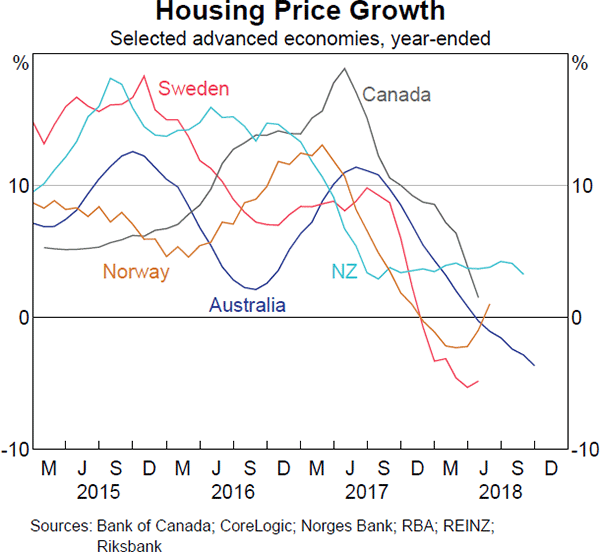
Commercial real estate prices continue to rise
Like other asset prices, commercial real estate prices have risen strongly in several advanced economies over recent years, including the United States, parts of the United Kingdom and continental Europe. Prices have been supported by the decline in long-term government bond yields over many years. This has raised the risk of a fall in prices in the event of a material further increase in interest rates. In some economies, the banking sector has substantial commercial real estate exposures, which in the past have been a major source of losses for banks. Commercial property lending standards in the United States have been tightened in recent periods. However, while risks in commercial real estate are rising in some jurisdictions, there have been few targeted policy measures to address these risks.
Bank health continues to improve in advanced economies
Banking sector conditions in advanced economies have generally continued to improve, though bank share prices remain lower than at the start of the year (Graph 1.7). Bank profitability has been supported by favourable economic conditions. Asset performance, as measured by non-performing loans (NPLs), has also improved further over the past six months.
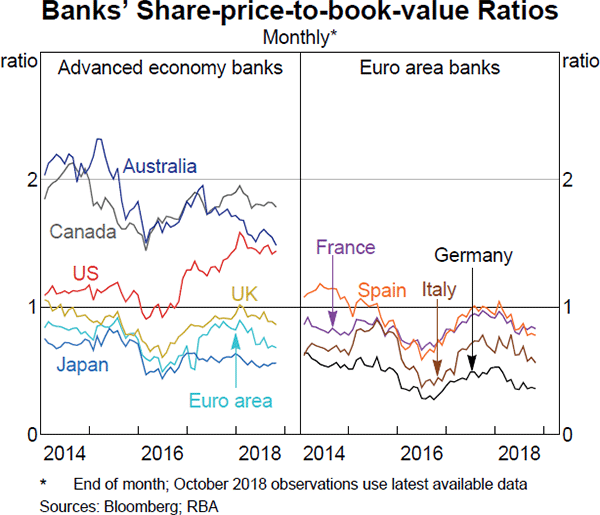
In the United States, the reduction in the corporate tax rate has boosted banks' profits this year. Bank lending has also remained strong at the smaller US banks, possibly supported by developments in financial regulation. A law changing parts of the Dodd-Frank Act was passed in late May, easing the regulatory burden on smaller banks and for large banks rolling back regulations that exceeded international standards. Federal financial regulatory agencies have also announced proposals to reform capital and other requirements. Combined, these developments may support financial stability in some ways, for example, by improving market liquidity and functioning. But they also imply an easing in capital and other prudential safeguards for some banks.
In recent months spreads on short-term bank debt in the United States have unwound much of their rise earlier this year, although they still remain higher than the very low levels in much of 2017 (Graph 1.8). The spike in spreads was due to changes in the supply of and demand for money market securities, rather than concerns about bank credit risk. However, the spike highlighted the increased sensitivity of money market interest rates to supply and demand changes, due to greater market segmentation. In part, this reflects enhanced global financial regulation and a greater focus on risk management by market participants. This has resulted in a reduced ability of market-makers to hold large positions and take advantage of price differences between money markets.[4] This change in market functioning raises some uncertainty about how the cost and availability of short-term funds may respond to a large shock.
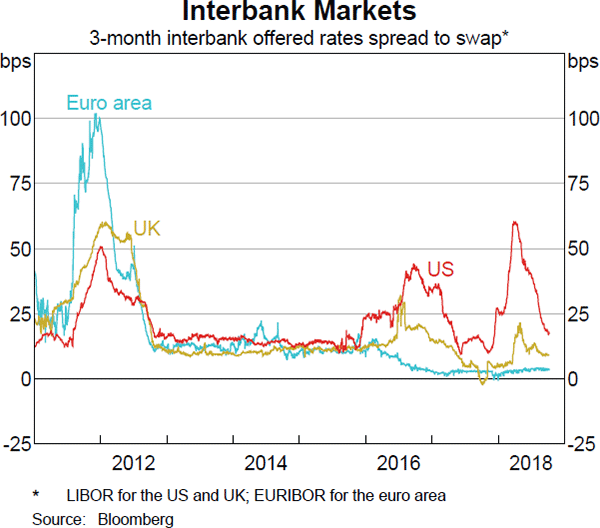
Some non-US banks continue to face US dollar liquidity risks. This arises when they borrow in short-term wholesale markets to provide funding for longer-term US dollar loans.[5] These banks generally use foreign exchange swaps to meet short-term currency needs. However, this market has been more volatile than other money markets in the past. This suggests that it may be an unreliable source of funding, particularly in times of stress.[6] Liquidity mismatches could be exposed by a negative shock and could trigger forced asset sales or even defaults, amplifying and transmitting market turbulence.
Japanese banks are striving to improve profitability in the face of low interest rates
The very low interest rate environment in Japan, and falling population, continues to weigh on banks' profits. To offset low profitability of traditional business, banks are increasingly lending to riskier domestic firms. Japanese banks have also continued to increase their lending in offshore markets, adding to their very large international exposures (Graph 1.9). This continues to be partly funded from short-term wholesale markets, resulting in foreign currency liquidity risks as noted above. Expanding into less familiar offshore markets or market segments also raises credit risks through potentially poorer lending quality.
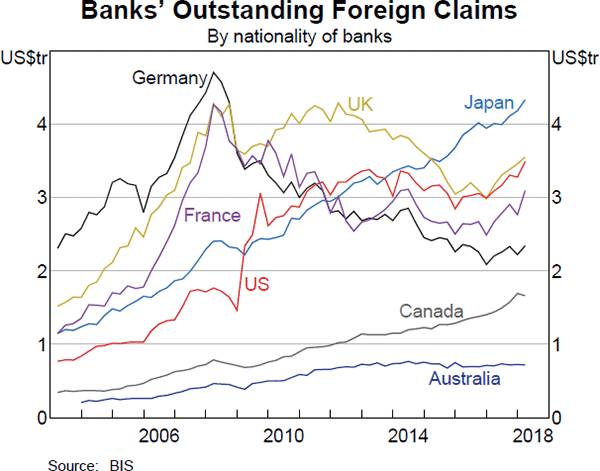
The health of European banks is improving, but they are still vulnerable
The ongoing economic expansion in Europe has been driving improved banking sector profitability (Graph 1.10). This has allowed banks to increase their loss-absorbing capital ratios, enhancing their resilience to negative shocks. The quality of banking sector loan portfolios has also continued to improve, with NPLs decreasing further, in part due to some large banks selling NPL portfolios.

However, profitability remains low, which makes banks vulnerable to negative shocks. In part, this is because they are only slowly generating the capital required to meet future regulatory requirements. The stock of NPLs is high in several European countries, raising uncertainty about the size of eventual losses and the impact on banks' capital buffers (Graph 1.11). Some European banks also have sizeable exposures to emerging market economies that have recently experienced large capital outflows.
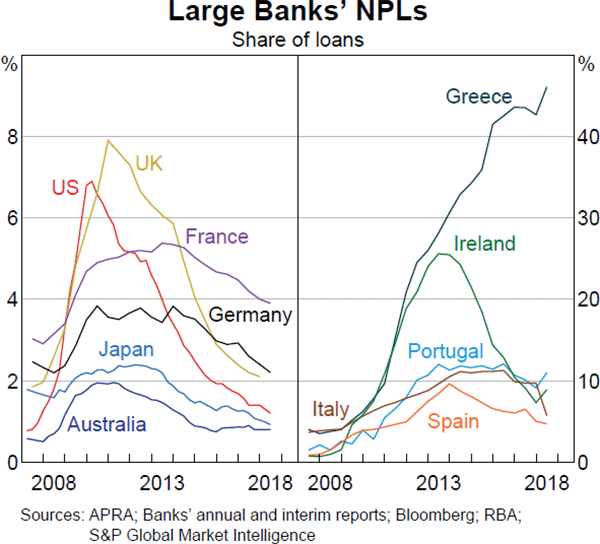
High sovereign debt remains a vulnerability in Europe
Sovereign debt remains at a high level in some European countries (Graph 1.12). The recent rise in interest rates and heightened political uncertainty increase the risk that debt sustainability concerns will re-emerge. European banks have large holdings of European government bonds and so would be drawn into any sovereign stress.
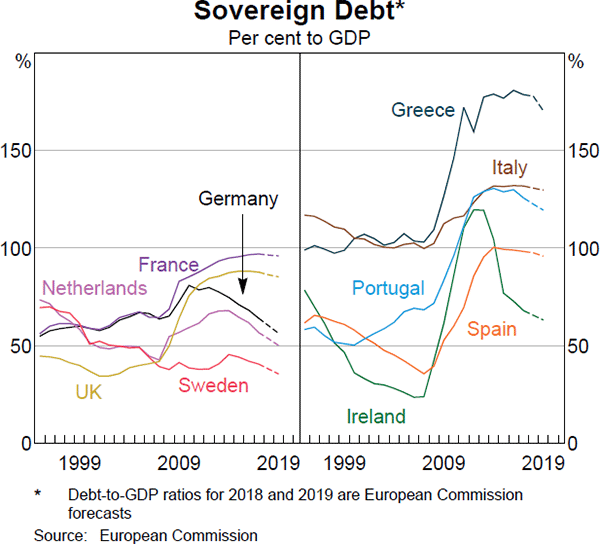
In Italy, political developments in May increased sovereign debt concerns. This followed the formation of a coalition government between two populist parties – the Five Star Movement and the Northern League – whose election campaigns featured a strong Eurosceptic stance and proposals for expansionary fiscal policy. Since forming government, the Eurosceptic rhetoric of the two parties has softened but the government has proposed to include expansionary fiscal measures in its 2019 budget, which will increase its budget deficit. Following the announcement of the proposed budget measures, Italian government bond yields rose sharply and equity prices fell amid fears that the deficit may not comply with EU fiscal discipline rules. The draft budget must be submitted to the European Commission by 15 October for approval. While the rise in government bond spreads to German Bunds has been largely confined to Italy, it highlights how quickly concerns about sovereign debt sustainability can re-emerge (Graph 1.13). Sovereign debt levels in Greece also remain around historically high levels. However, near-term funding pressures have receded after the government negotiated a debt restructuring package with other Euro area countries.

The United Kingdom's exit from the European Union (Brexit) also poses risks to financial stability in Europe. Negotiations to define the future relationship between the two regions are ongoing, and the outcome remains highly uncertain. The likelihood of a disorderly Brexit without a pre-agreed deal has seemingly increased. This could have a large impact on the stability and growth of both the United Kingdom and the Republic of Ireland (given its strong trading links with the United Kingdom), with a somewhat lesser impact on other EU countries. The largest impact to growth and stability from a disorderly Brexit would be caused by lower trade volumes and disruptions to financial services.
Risks have stabilised in New Zealand
Financial stability risks in New Zealand are of key interest given Australian banks own New Zealand's major banks. The latest Reserve Bank of New Zealand (RBNZ) Financial Stability Report noted that the risks to New Zealand's financial system have stabilised but that household and dairy sector debt remain two large domestic vulnerabilities.
Over the past year, housing credit growth in New Zealand has slowed and housing price growth has stabilised at a low rate (Graph 1.14). An important contributing factor has been the general tightening in banks' lending standards (banks have reduced the amount they are willing to lend relative to incomes and have also reduced their interest-only lending). But household debt remains at historically high levels relative to income, leaving households vulnerable to negative shocks.
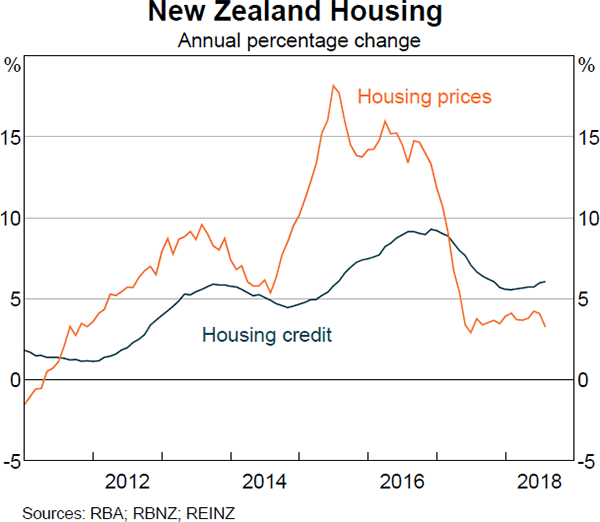
Risks to New Zealand's dairy sector have not materially changed over the past six months. Dairy farm incomes remain significantly higher than the very low levels seen two years ago, due to higher dairy prices, with most dairy farms currently profitable. The stock of debt has stabilised, but it remains historically high relative to income. Debt is concentrated among more highly leveraged dairy farms, and these farms remain vulnerable to negative shocks, such as a fall in sometimes volatile dairy prices.
In light of reviews in Australia, the RBNZ, together with the New Zealand Financial Markets Authority, is conducting a review into the Australian banks' New Zealand subsidiaries to assess whether conduct and culture problems are present. The results of the review are expected to be released by November.
Chinese authorities continue to address financial stability risks
Since the last Review, Chinese authorities have continued with their efforts to address financial stability risks. A wide range of reforms and policy actions have been implemented or proposed (see ‘Box A: Ongoing Financial Regulatory Reform in China’). The authorities have focused on measures to tackle high debt levels and to reduce risks related to non-bank financial institutions' (NBFIs) activities. These reforms are helping to contain the build-up of financial stability risks in China.
The rapid growth of debt to a high level in China remains a key risk. Such build-ups in other countries have often preceded financial crises. Indeed, China's non-financial corporate debt relative to GDP, which includes both public and private enterprises, exceeds that of most advanced economies (Graph 1.15). It is also several times higher than in economies with comparable per capita income levels.
The growth of debt in China has slowed over recent years. But the speed and scale of the earlier increase in debt suggests that some lending may have been of poor quality, as has often been the case in rapid credit expansions in other countries. Implicit guarantees – for many banks and state-owned enterprises – are also likely to have resulted in weaker lending standards. There remain many unprofitable companies in parts of the industrial sector, given excess capacity, that are highly leveraged and rely on loan forbearance to survive. The flow of new NPLs has increased noticeably over recent years, suggesting rising credit risks. Corporate bond defaults have also increased. However, they remain low and the increase may largely reflect less intervention by the authorities in order to reduce perceptions of implicit guarantees.
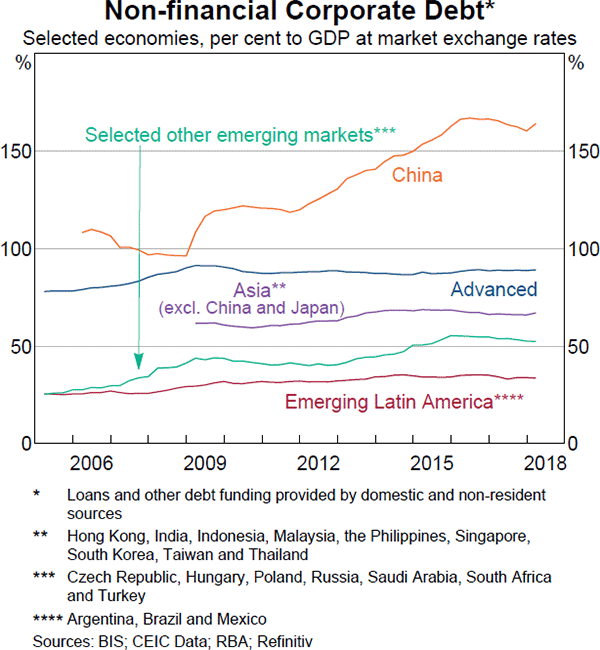
Over recent years, the authorities in China have worked to facilitate the restructuring of corporate debt, especially of state-owned enterprises. This includes launching a debt-to-equity swap program, establishing firm-level creditor committees to manage debt workouts, and creating regional asset management companies to purchase NPLs. Despite the efforts by the authorities, progress on the debt-to-equity swap program has been slow, with only a small portion of the originally announced swap deals completed.
Local governments – and their corporate financing vehicles – have borrowed heavily in the past decade, particularly to fund infrastructure. Generous access to finance and political incentives to support short-term growth have likely led to some poor investment decisions. Growth in local government debt has been moderate of late. Local authorities have been focused on a debt restructuring program – involving refinancing bank loans and off-balance sheet borrowing with local government bonds – designed to reduce debt servicing costs and increase transparency. However, central authorities have recently urged local governments to support infrastructure investment, albeit in a targeted fashion to avoid a sharp run-up in debt.
Much of the run-up in debt in the post-crisis period has been facilitated by the less regulated and less transparent NBFIs. Most of this lending is ultimately funded by the banking sector. While this lending has some benefits, it has allowed banks to circumvent restrictions on lending to riskier sectors and to arbitrage regulatory capital requirements. The riskier nature of the lending, and the obscure and complex interconnections between NBFIs and the banking sector, have led to the build-up of considerable credit, liquidity and contagion risks. Loan losses and defaults have been modest to date. But if they were to escalate, it could result in funding pressures in the non-bank sector, which could cascade through the financial system.
The Chinese authorities have increasingly focused on addressing these financial stability risks over recent years. As noted in ‘Box A: Ongoing Financial Regulatory Reform in China’, regulatory reforms have led to a pronounced slowing in credit provided through NBFI channels. The degree of interconnection between banks and NBFIs also appears to be stabilising. In particular, banks' claims on NBFIs have levelled out, which has driven a sharp slowing in banks' asset growth, particularly among smaller banks (Graph 1.16). Accordingly, the reform efforts seem to be containing the build-up of risks related to rapid debt growth and non-bank activity in China.
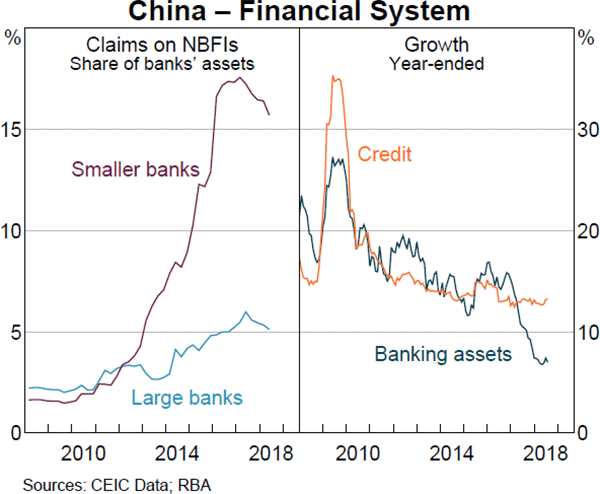
Recently there has been some targeted loosening of monetary and fiscal policy in response to signs of slower GDP growth. The implementation of some financial regulatory reforms has also slowed at the margin to avoid disrupting the financial sector and associated negative effects on activity. This has brought into focus the difficult trade-off between addressing medium-term risks and supporting near-term growth. For now the authorities' commitment to addressing financial stability risks in China remains strong.
Increasing leverage in the Chinese household sector is an emerging risk. Chinese household debt has grown rapidly alongside strong growth in housing prices over recent years. Household indebtedness in China is high relative to economies with comparable income levels, but lower than in advanced economies. The risk of a sharp decline in housing prices, which would also negatively affect property developers and local governments, is mitigated by the authorities' active management of the housing market using a variety of tools.
The Chinese banking system indicators are generally positive (Graph 1.17). Aggregate profitability is quite strong, despite declining in recent years due to loan write-offs. Reported capital, while high, may overstate the true position as some banks with material off-balance sheet exposures or loose NPL recognition practices might be under-provisioning for NPLs. With standards for NPL recognition strengthening, a further rise in reported NPLs seems likely as some off-balance sheet exposures and special mention loans are reclassified as non-performing. Small and medium-sized banks could come under some pressure from the financial regulatory reforms. These banks have been most active in channelling funds borrowed from short-term wholesale markets to the non-bank sector and their asset growth has already slowed sharply as a result of the reforms. Some also have relatively thin capital buffers over their minimum requirements.
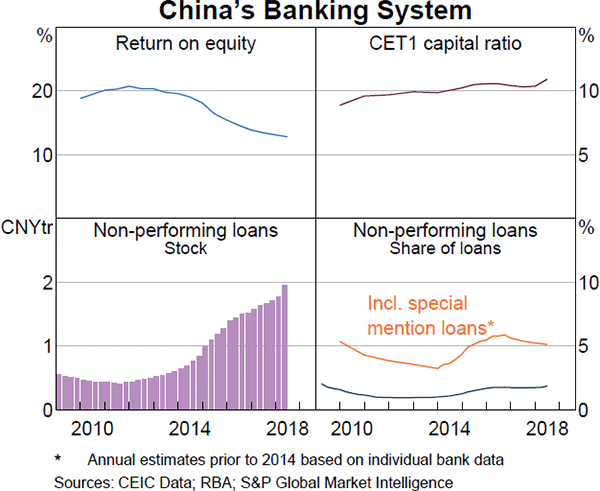
The Chinese authorities retain a wide range of economic and financial policy tools to both prevent and address any financial disruption. The state has a large role in both the corporate sector and the financial system, which enables coordinated policy actions that are more complex or not possible in other economic systems. Nonetheless, if systemic financial risks were to materialise in China, the negative effect on China's economy could be substantial. Financial linkages between China and the rest of the world are generally still small, limiting direct financial spillovers. Rather, a financial disruption would likely be transmitted through China's strong trade links – including with Australia – with second-round effects through weaker global growth and sentiment.
Some emerging market risks are beginning to materialise
Investor sentiment towards some other EMEs has deteriorated since earlier this year, resulting in tighter financial conditions. Capital outflows from some EMEs have picked up, following strong inflows over the preceding year or so (Graph 1.18). EME currencies have depreciated, in some cases significantly (Graph 1.19). Equity markets have fallen and bond yields have increased. Rising US interest rates and a higher US dollar have contributed to these developments. But investors have also increasingly focused on EMEs' domestic and external vulnerabilities. The countries most affected by the change in market conditions, such as Turkey and Argentina, face some combination of elevated external financing needs, weak institutions, poor or uncertain macroeconomic policy, and economic headwinds. EMEs in Asia – with which Australia has stronger macroeconomic and financial linkages – have been less affected by the deterioration in investor sentiment. However, there is a risk that capital outflows and funding pressures could broaden and intensify, particularly if financial conditions in advanced economies were to tighten noticeably.
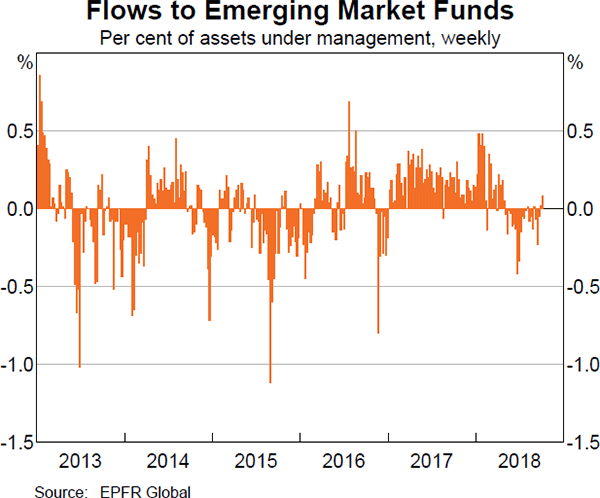
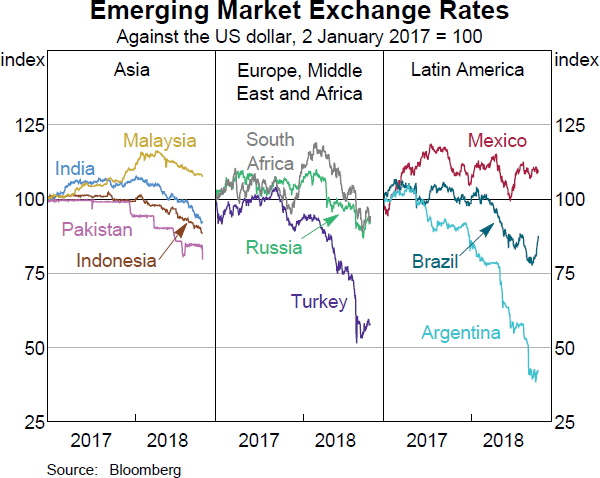
These pressures present a near-term risk to financial stability in EMEs, albeit to a varying degree across countries. Servicing or rolling over existing debt will be more difficult for some EME sovereigns and corporations where debt has risen strongly (Graph 1.20). Increases in debt-servicing requirements will be particularly acute for unhedged foreign currency borrowing, which will have risen in local currency terms due to depreciating exchange rates. For the corporate sector, this is somewhat mitigated by the large proportion of listed EME firms that have at least some foreign currency earnings.[7]
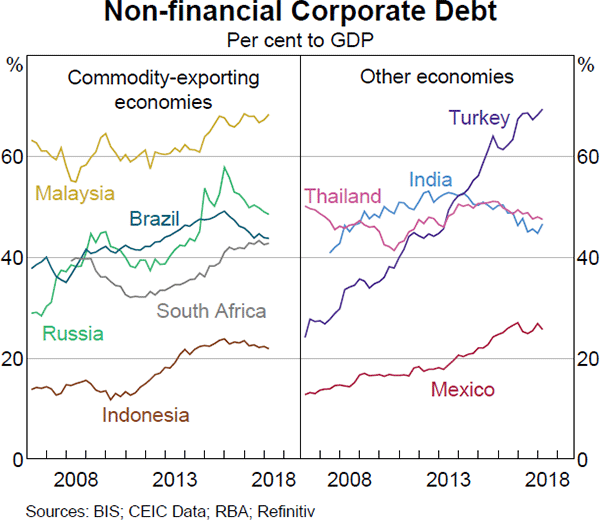
The risk of financial and macroeconomic instability is particularly severe in Turkey. The Turkish lira has fallen significantly and government bond yields have risen by around 7 percentage points since the previous Review. This reflects concerns about Turkey's large and widening current account deficit, growing inflationary pressures, and an apparent decline in the independence of the central bank and the credibility of economic policy more generally (Graph 1.21). The relatively high indebtedness of its corporate sector, following very strong growth in the post-crisis period, is also a key vulnerability. Around half of this debt is denominated in foreign currencies, much of which is intermediated by the banking system.
Argentina has also been particularly affected by the change in market sentiment. The peso has depreciated sharply over recent months amid concerns about widening current account and budget deficits, rapid inflation, a considerable stock of external debt, and declining economic policy credibility. In response, the Argentine central bank has increased interest rates by more than 30 percentage points and intervened in the foreign exchange market. The authorities also negotiated a large financial assistance package with the International Monetary Fund in May. The assistance package was subsequently increased in late September.
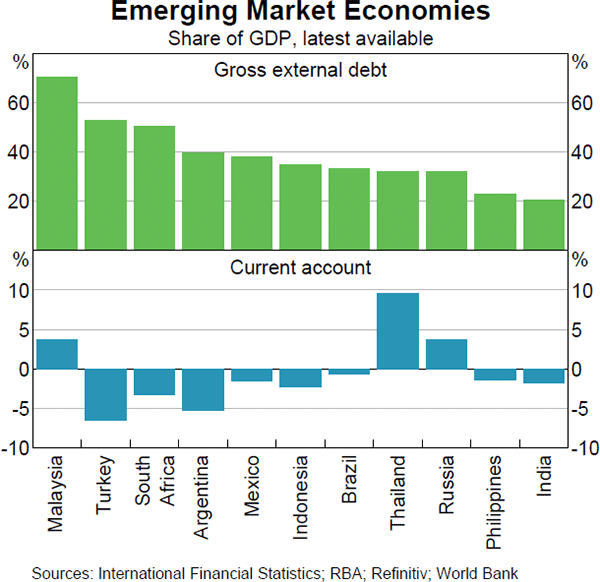
In contrast, EMEs in Asia have been relatively less affected. This can be attributed to efforts by policymakers there to build more resilient institutions, economies and financial systems in the two decades since the Asian financial crisis.[8] In particular, EMEs in the region generally have much larger foreign currency reserves, stronger current account positions, lower external debt and stronger economic fundamentals than other EMEs.
The varying extent to which EMEs have been affected by the change in market sentiment is consistent with evidence that investors have discriminated between different EMEs.
However, a more broad-based retreat from EME assets by investors remains a possibility. This could be triggered by tighter financial conditions in advanced economies, perhaps due to stronger-than-expected inflation in the United States. A broad-based rebalancing of investors' portfolios, and the associated tightening in financial conditions in EMEs, could exacerbate any perceived vulnerabilities, further undermining investor sentiment. In the Asian region, EMEs' exposures to global trade and linkages to China could result in investor sentiment being particularly affected by escalating trade tensions and slowing growth in China.
EME banking systems have been fairly resilient in the face of some challenging economic conditions in recent years and some deterioration in asset performance. Most emerging market banking systems appear well capitalised and profitable, although bank performance varies widely within and across jurisdictions. However, the tightening in financial conditions and economic headwinds facing many EMEs are likely to present some challenges for their banking systems.
The reported NPL ratio remains high and rising in India, mainly reflecting a number of measures implemented by regulators to improve NPL recognition and resolution (Graph 1.22). The deterioration in asset quality at Russian banks has moderated somewhat lately, following a run-up in NPLs since late 2013. Russian authorities have closed down a large number of banks and injected capital into some other banks to bolster resilience. The authorities are expected to complete an asset quality review of the entire banking system by the end of 2018.
The potential for EME financial stress to spill over to advanced economies has risen over time, due to EMEs' increased size and integration into the global economy. Along with stronger trade links, advanced economies' financial links to EMEs – while relatively small – have grown. Investments in EME corporate debt and equity (especially via mutual funds) have risen. Distress in EMEs could be transmitted through these links and by weighing on financial market sentiment more generally.
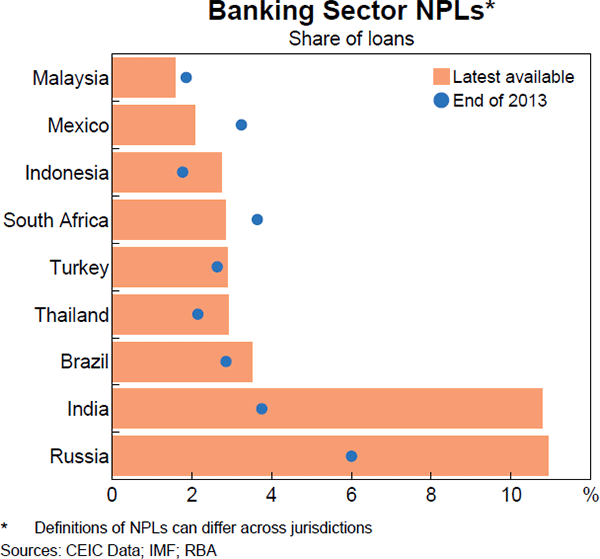
Footnotes
For further details, see RBA (2018) ‘Box A: Low Interest Rates and Asset Price Risk’, Financial Stability Review, April, pp 15–18. [1]
For example, see IMF (2017) ‘Global Financial Stability Report’, October, pp 29–32. [2]
Funds are considered ‘open-ended’ if the number of units in the fund is not fixed. Subscriptions increase the number of units, while redemptions reduce them – with both transactions occurring at the prevailing net asset value of the fund. If a large number of units are redeemed, the fund will have to sell investments to repay the investor. [3]
For example, enhanced regulation has made market-making activity more capital intensive and subject to stricter liquidity risk requirements. Accordingly, profit margins from market-making have declined from already low levels, resulting in less market-making activity. [4]
While banks may meet the Basel III Liquidity Coverage Ratio standard, this is measured on an all-currency basis, so liquidity ratios for specific currencies may be significantly lower. [5]
For further analysis, see IMF (2018) Global Financial Stability Report, April, pp 38–46. [6]
For more details, see Kofanova S, A Walker and E Hatzvi (2015), ‘US Dollar Debt of Emerging Market Firms’, RBA Bulletin, December, pp 49–57. [7]
For more details, see RBA (2018) ‘Box A: Financial Market Resilience of Emerging Asia’, Statement on Monetary Policy, August, pp 22–24. [8]